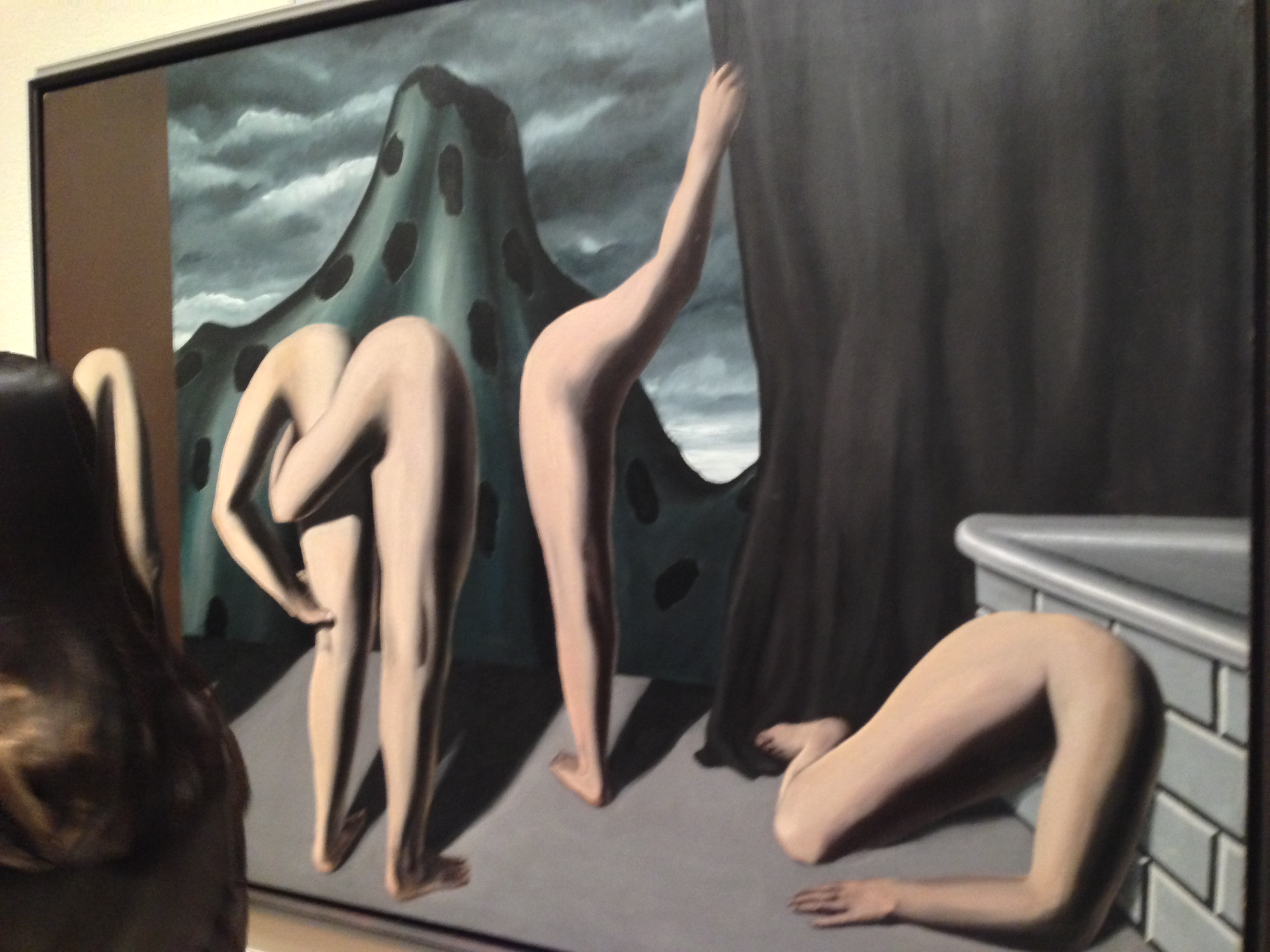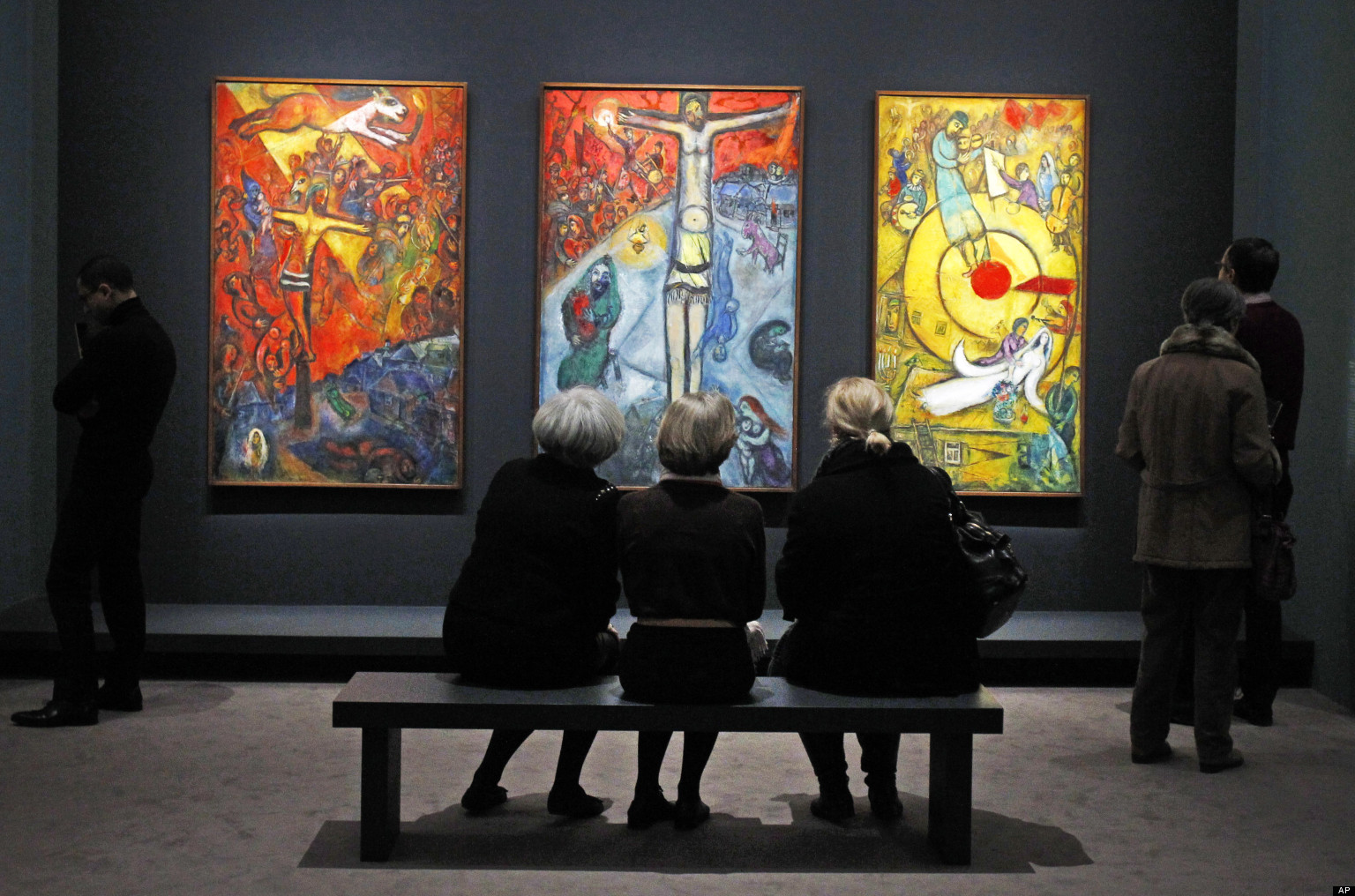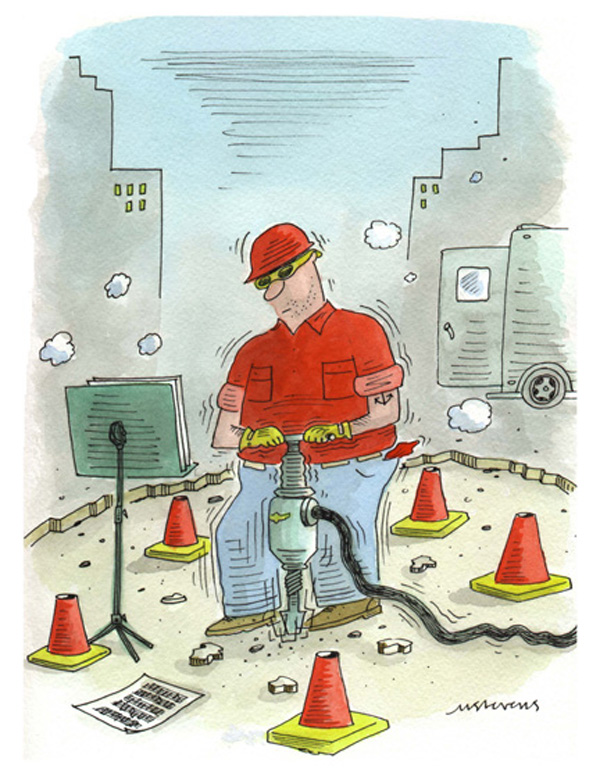LordFlea’s Views on Some Great AhRT
Here’s a Magritte from recent exhibition at MOMA in NYC
This image from recent Chagall show in Paris, not seen in NYC
Dear Jane,
Your letter was amazing, considering you were sitting in a bathtub nearly asleep. I’m impressed. I hope these electronic devices don’t shock you in such circumstances.
Because you asked I’ll briefly describe my feelings about the recent Chagall and Magritte shows I saw while in New York City.
Chagall’s use of color is mind blowing to me, and the brush strokes he uses are very spontaneous, like he’s breathing the painting process (as opposed to Magritte’s, which is almost minimal, controlled, and real thin, like a watercolor wash at times).
The imagery Marc C started using early in his life was from his dreams, or imagination, which at that time was very risky. He was brave. He painted bravely with his colors juxtapositioning the real-unreal, and he was extremely courageous depicting “life” in the Russian shetl of his youth as an imaginary flight of fancy. I’m sure he took a LOT of slack from his peers, rabbi, etc. in his little village for doing so. This is brave art.
Also, his use of Christ on the Cross was a real surprise, one that Carter and I both weren’t expecting. I thought I knew about Chagall’s work (in my mind he is a surrealist, always, and a colorist) but neither of us knew about his “hidden messages” conveyed through the use of the “icon” Jesus. There he is, the Jew of Jews (at least the Romans said so on the sign above his criminal’s cross: INRI, king of Jews, mocking him). I believe, from seeing the way he used the crucifixion scene, over and over, even with “baby blue Jesus” in one, more abstracted work, that he felt Jesus epitomized the suffering of the Jews during the nazi regime. With the black and white shawl across Jesus’s loins (I forget what the Jewish prayer shawl is called) he isn’t depicting Jesus as an emblem of Christianity, but as the height of Jews being misunderstood, stigmatized, ostracized … and killed in the nazi world that Chagall knew all too well (he fled Europe to escape them, remember).
Speaking of Jews and nazis, I highly recommend the book i just finished, Edmund de Waal’s “The Hare with Amber Eyes.” It’s a scholarly memoir, an inside view of what it was like to be Jewish … for about 100 years before and after the nazis. follows a family of bankers, from Vienna, who lost everything during the nazi occupation. The read was not crushingly sad so much as very informative, and shockingly real. A collection of Japanese netsukes is the theme, as the collection of these small sculptures passed from family member to family member from Paris, to Vienna, to Hong Kong, to the UK.
As for Magritte’s show:
So funny, but I was standing (yes, it was very crowded, both shows!) staring at one of the early pieces and this funny little man, about 45, balding, working class, wearing a black T-shirt with motorcycle logos on it, comes up to me and says, so sweetly emboldened wanting to know about ahrt, I suppose) … “So … what’s all this mean????” And thus began my humorously fueled rapport all throughout the next hour of viewing stunning Magrittes, describing what they meant to me to Johnny. He was all aglow, and soon “got it” and was able to pick out the different motifs (people represented by weird cut-outs reed-like paper, the rounded columns, his mistrust of words, the mix of dream and reality, etc.) so by the time Carter found us, the three of us continued amid the tidal wave of people, standing and discussing different works that stood out to each of us. We had a blast! Especially seeing the Light! go on in Johnny’s eyes as he began to make sense of what before, to him, was incomprehensible hog-wash. Ahrt. Now he began to sense the power of what Art, good art, can convey.
Carter, my consort’s favorite Magritte was the ham with an eyeball in the middle, very simple composition: a bottle of wine, a glass, a fork and knife. We all agreed it was “you are what you eat” … the way Carter is NOW living. So he was drawn to that one. Here’s a bad shot of it from my iphone (yes, I illegally took photos, bad Lordflea!) But you can’t really “see” the human eyeball in the middle of that hamsteak, can you? dern.
My fav?: well, the famous one where he paints a pipe and says: “Ceci ne c’est pas un pipe.” Of course! This means how words are so fickle, and as a writer and artist, who has always had a hard time trying to decide WHICH of these two mediums I ought to trust to communicate the important stuff i have in my mind and heart, I can relate. But I love Magritte’s MIND. The way he analyses life. It’s all a big puzzle to him, and his paintings are like clue in a murder mystery, sending out little messages for his viewer to “get it” whatever “it” is that Magritte gets turned on by. And apparently, I like puzzles, and I like to try to figure out what Magritte’s “message’ it. Most of his works, I could, but only a few left me scratching my head.
My new friend Mick Stevens is a NYorker cartoonist, and I find trying to figure out his (and other NYorker toons) the same as looking at a Magritte. They’re puzzles in images. Here’s one of Mick’s I’ve borrowed from his website.
The painting style of Magritte is pretty flat, like I said, but he does what he needs to do, paints fast, with little paint, no extra brush stroke and gets the hell out of painting as soon as he supplies the clues he wants to share about whatever subject, or dream, or news item he’s focused on. Minimalism, for sure. He must be the Grandpappy of it, although REAL minimalism, I would say, didn’t start for another thirty-forty years after Magritte’s first use of minimal painting.
that’s my art lesson aka LordFlea
love ya, teZa




greatttt stufff… oooo’s to you and carter from colorado Date: Wed, 6 Nov 2013 16:45:46 +0000 To: imsuzabella@hotmail.com